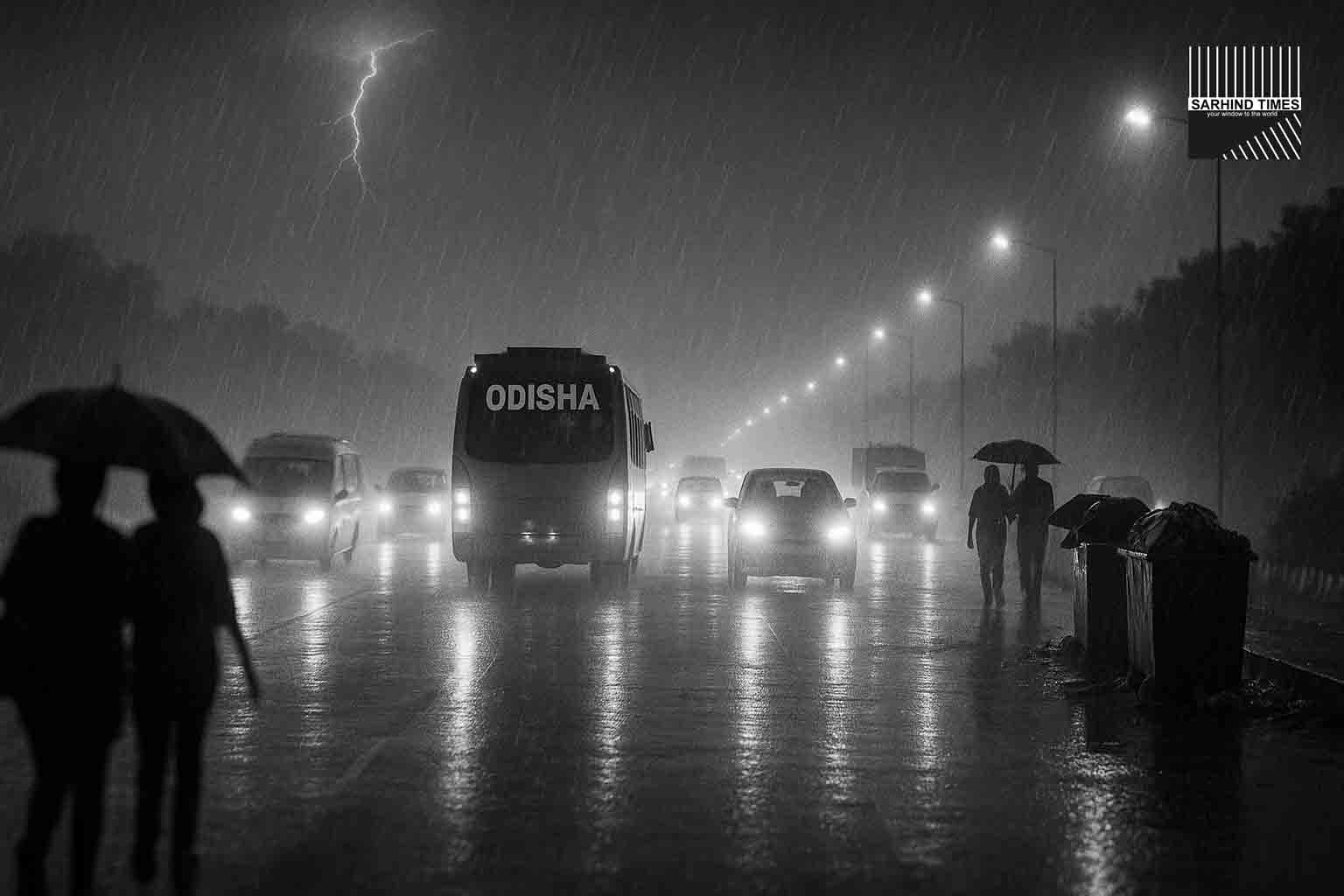India Meteorological Department issues fresh advisories for Odisha, Northeast states, and coastal South India as festive travel coincides with unstable post-cyclone conditions.
By SarhindTimes Weather Bureau
New Delhi, October 2025
Unsettled Skies Across India’s Map
As millions prepare for festive journeys this week, the India Meteorological Department (IMD) has warned that unsettled weather will persist over eastern, northeastern, and southern India, driven by moisture influx, residual cyclonic circulation, and monsoon withdrawal transitions.
While Odisha and the Northeast brace for intermittent rain and thunderstorms, southern states are experiencing post-cyclone turbulence after the weakening of Cyclone Shakthi in the Bay of Bengal.
The IMD’s bulletins emphasize the need for caution among travellers, farmers, and coastal residents, as the weather system continues to evolve across regional corridors.
Eastern India: Odisha on Rain Radar
According to the IMD’s regional outlook, Odisha will see light to moderate rainfall with isolated heavy spells between October 10 and 12, particularly over the coastal and adjoining interior districts such as Puri, Ganjam, and Cuttack.
The rains are linked to a low-pressure remnant over the east-central Bay of Bengal, coupled with a trough extending toward the northeast.
“Moisture incursion from the Bay, combined with wind convergence, will keep the region unstable,”
said Dr. Mrutyunjay Mohapatra, Director-General of Meteorology, IMD.
“Thunderstorms with lightning are likely, and isolated areas could see short-duration heavy rainfall.”
The Odisha government has instructed district collectors to remain on alert for localized flooding and urban waterlogging, especially in Bhubaneswar and Cuttack where drainage systems remain strained from previous showers.
Northeast: Assam, Meghalaya Brace for More Rain
In the Northeast, the IMD has flagged episodes of rain and thunderstorms over Assam, Meghalaya, Arunachal Pradesh, and Nagaland, driven by the same trough line extending from eastern India.
While the intensity is expected to be moderate, the region’s topography and saturated soils could amplify risks of landslides in hill districts and riverbank erosion in flood-prone belts.
“The combination of moisture feed from the Bay and Himalayan orography enhances rainfall,”
said Dr. Sanjay O’Neill Shaw, IMD Northeast head.
“We’ve issued yellow and orange alerts for parts of Meghalaya and Assam.”
Fishermen in the Brahmaputra basin have been cautioned about fluctuating river levels, and transport departments have urged bus and truck drivers to avoid hilly stretches during heavy downpours.
Southern India: Cyclone Shakthi’s Aftermath
In the southern peninsula, residual energy from Cyclone Shakthi—which weakened into a depression over the Arabian Sea earlier this week—continues to influence coastal weather patterns.
States including Tamil Nadu, Kerala, Andhra Pradesh, and Karnataka have reported gusty winds, sporadic heavy rainfall, and choppy sea conditions since Tuesday.
“Even as the system dissipates, the atmosphere retains kinetic instability,”
explained Dr. Soma Sen Roy, IMD scientist (climate monitoring).
“We expect intermittent bursts of rain and thunder along the western coastline.”
The Kerala State Disaster Management Authority (KSDMA) issued warnings against venturing into the sea along Kollam, Alappuzha, and Ernakulam coasts, citing rough waves and potential wind shear hazards.
Meanwhile, fishing activities remain suspended in stretches of the Gulf of Mannar and Lakshadweep regions.
Central India: Calm Between Systems
While East and South grapple with moisture, Central India — including Madhya Pradesh and Chhattisgarh — is witnessing transitional calm as the monsoon trough weakens.
Scattered rainfall may continue in isolated pockets, but the region is largely seeing a decline in humidity and a gradual rise in daytime temperatures.
Northwest: Clear Skies, Cooling Nights
In contrast, Northwest India is turning the seasonal page.
The monsoon withdrawal line has reached western Uttar Pradesh and Haryana, signaling the start of cooler, drier conditions.
Delhi, Punjab, Haryana, and Rajasthan have recorded a 3–4°C drop in night temperatures since last week. However, the IMD has warned that post-withdrawal calm often coincides with crop-residue burning, which could deteriorate air quality in the Indo-Gangetic plains.
“We urge farmers to adopt stubble alternatives and avoid open burning,”
said Dr. Kuldeep Srivastava, IMD Regional Director (Delhi).
“The air remains stagnant during early October, amplifying pollutant concentration.”
Travel and Safety Advisory
With the festive season coinciding with unsettled skies, the IMD has issued travel and safety guidelines:
- Road Travellers: Avoid water-logged underpasses and low-lying routes in Odisha, Meghalaya, and coastal Tamil Nadu.
- Air Passengers: Check for flight advisories at Visakhapatnam, Chennai, and Kochi airports, where wind shear and reduced visibility may cause delays.
- Farmers: Secure freshly harvested produce and maintain field bunds to prevent crop damage.
- Coastal Residents: Refrain from sea activities until local administrations lift advisories.
- General Public: Follow IMD’s nowcast updates on the Mausam and Meghdoot mobile applications.
“Localized downpours can intensify within an hour,” warned Dr. Mohapatra.
“Real-time updates are the best defense for travellers and farmers alike.”
Impact on Aviation and Shipping
Meteorological officers in Chennai and Bhubaneswar reported episodes of wind shear, a phenomenon that can disrupt aircraft during takeoff and landing.
Airlines have been instructed to maintain flexible scheduling, especially for short-haul domestic routes in South and East India.
In maritime zones, the Indian Coast Guard has extended rough-sea alerts for the east-central Bay and south Arabian Sea till October 12. Cargo vessels have been advised to re-route through calmer channels.
Agricultural Outlook: Silver Lining for Rain-Fed Crops
While urban India braces for travel disruptions, farmers in rain-fed belts of Odisha, Jharkhand, and Assam could see benefits from residual moisture.
“Soil replenishment during the tail end of the monsoon is crucial for rabi crop planning,”
said Dr. Trilochan Mohapatra, agricultural scientist and former ICAR DG.
However, experts caution that excess rain could damage harvested paddy, especially in areas without storage infrastructure. Farmers are advised to cover threshing floors and store produce above ground level.
Climate Context: Post-Monsoon Instability on the Rise
Meteorologists note that such late-season weather volatility has become more frequent in recent years.
Residual cyclonic systems and unseasonal rain spells in October are increasingly linked to warming sea surfaces and delayed monsoon withdrawal patterns.
“The Bay of Bengal and Arabian Sea are both running above-normal temperatures,”
said Dr. Roxy Mathew Koll, climate scientist at IITM Pune.
“That extra heat acts as a battery for post-cyclone instability.”
Climate models indicate a trend toward prolonged monsoon tails, with October witnessing more cyclonic remnants and thundershower events than two decades ago.
Festive Travel: What to Expect This Week
| Region | Expected Conditions | Travel Advisory |
| Odisha & Bengal Coast | Light to moderate rain; isolated heavy falls | Avoid long-distance driving during peak rain hours |
| Assam, Meghalaya, Nagaland | Thunderstorms; localized flooding possible | Check road advisories in hill districts |
| Tamil Nadu, Kerala, Coastal Andhra | Gusty winds; heavy rain pockets | Fishermen and small boats to stay ashore |
| Delhi, Punjab, Haryana | Clear skies; cooler nights | No rain expected, but air quality may worsen |
| Western India (Gujarat, Maharashtra) | Mostly dry | Ideal for travel |
Public Messaging: From Forecasts to Preparedness
The IMD emphasized that weather awareness must move from forecast consumption to action.
In recent years, even light rainfall episodes have triggered traffic gridlocks, localized flooding, and power outages — largely due to poor infrastructure and unheeded warnings.
“Forecasts are only as effective as public response,”
said Dr. Sunitha Devi, IMD’s Head of Disaster Support Services.
“We encourage local governments to integrate IMD data into civic response systems.”
Environmental Ripple: The AQI Angle
As rainfall eases dust but stubble fires resume in the north, meteorologists anticipate a mixed AQI outlook.
While Odisha and Assam may temporarily enjoy cleaner air due to washouts, Delhi and Haryana could see AQI deteriorate to “poor” by mid-October.
“The paradox of India’s post-monsoon season is clear skies but dirty air,”
said Anumita Roychowdhury, Centre for Science and Environment (CSE).
“We need a coordinated plan linking air, crop, and climate policies.”
Editorial Analysis: A Season of Transition
India’s October weather is often a study in contrasts — withdrawal in one corner, revival in another.
This year’s lingering monsoon activity, coupled with cyclone Shakthi’s leftovers, underscores the fragility of climate balance across sub-regions.
The takeaways are twofold:
- IMD’s localized nowcasts and district alerts remain the first line of defense.
- Infrastructure resilience — drainage, power lines, and coastal safety systems — must catch up with evolving climate volatility.
As festive mobility surges, preparedness — not panic — should define the public mindset.
Conclusion: From Monsoon to Mindfulness
As the country transitions from monsoon to winter, the week’s weather pattern serves as a reminder that India’s climate calendar no longer follows strict scripts.
For now, rain clouds linger over the East, gusts buffet the South, and the North wakes up to crisp mornings.
The IMD’s message remains consistent:
“Watch the sky, heed the alerts, and travel safe.”
#IMD #Weather #Cyclone #TravelAdvisory #Monsoon #Northeast #Odisha #Climate #Rainfall #IndiaWeather






















+ There are no comments
Add yours